Curtain array
Curtain arrays are a class of large multielement directional radio transmitting wire antennas, used in the shortwave radio bands.[1] They are a type of reflective array antenna, consisting of multiple wire dipole antennas, suspended in a vertical plane, often in front of a "curtain" reflector made of a flat vertical screen of many long parallel wires.[1] These are suspended by support wires strung between pairs of tall steel towers, up to 90 m (300 feet) high.[1] They are used for long-distance skywave (or skip) transmission; they transmit a beam of radio waves at a shallow angle into the sky just above the horizon, which is reflected by the ionosphere back to Earth beyond the horizon. Curtain antennas are mostly used by international short wave radio stations to broadcast to large areas at transcontinental distances.[1]

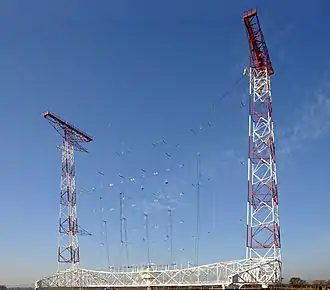
Because of their powerful directional characteristics, curtain arrays are often used in government propaganda radio stations to beam propaganda broadcasts over national borders into other nations. For example, curtain arrays were used by Radio Free Europe and Radio Liberty to broadcast into Eastern Europe.
History
Curtain arrays were originally developed during the 1920s and 1930s when there was a lot of experimentation with long distance shortwave broadcasting. The underlying concept was to achieve improvements in gain and/or directionality over the simple dipole antenna, possibly by folding one or more dipoles into a smaller physical space, or to arrange multiple dipoles such that their radiation patterns reinforce each other, thus concentrating more signal into a given target area.
In the early 1920s, Guglielmo Marconi, pioneer of radio, commissioned his assistant Charles Samuel Franklin to carry out a large scale study into the transmission characteristics of short wavelength radio waves and to determine their suitability for long distance transmissions. Franklin invented the first curtain array aerial system in 1924, known as the 'Franklin' or 'English' system.[2][3]
Other early curtain arrays included the Bruce array patented by Edmond Bruce in 1927,[4] and the Sterba curtain, patented by Ernest J. Sterba in 1929.[5] The Bruce array produces a vertically-polarised signal; Sterba arrays (and the later HRS antennas) produce a horizontally-polarised signal.
The first curtain array to achieve popularity was the Sterba curtain, patented by Ernest J. Sterba in 1929[5] and this was used by Bell Labs and others during the 1930s and 1940s. The Sterba curtain is however a narrowband design and is only steerable by mechanical means.
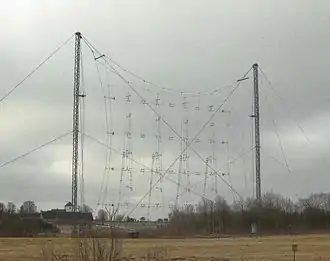
Curtain arrays were used in some of the first radar systems, such as Britain's Chain Home network. During the Cold War, large curtain arrays were used by the Voice of America, Radio Free Europe, and Radio Liberty, and analogous Western European organizations, to beam propaganda broadcasts into communist countries, which censored Western media.
Description
The driven elements are usually half-wave dipoles, fed in phase, mounted in a plane 1⁄4 wavelength in front of the reflector plane.[1] The reflector wires are oriented parallel to the dipoles. The dipoles may be vertical, radiating in vertical polarization, but are most often horizontal, because horizontally polarized waves are less absorbed by earth reflections.[1] The lowest row of dipoles are mounted more than 1⁄2 wavelength above the ground, to prevent ground reflections from interfering with the radiation pattern.[1] This allows most of the radiation to be concentrated in a narrow main lobe aimed a few degrees above the horizon, which is ideal for skywave transmission.[1] A curtain array may have a gain of 20 dB greater than a simple dipole antenna.[1] Because of the strict phase requirements, earlier curtain arrays had a narrow bandwidth, but modern curtain arrays can be built with a bandwidth of up to 2:1, allowing them to cover several shortwave bands.[1][6]
Rather than feeding each dipole at its center, which requires a "tree" transmission line structure with complicated impedance matching, multiple dipoles are often connected in series to make an elaborate folded dipole structure which can be fed at a single point.
In order to allow the beam to be steered, sometimes the entire array is suspended by cantilever arms from a single large tower which can be rotated. See ALLISS-Antenna. Alternatively, some modern versions are constructed as phased arrays in which the beam can be slewed electronically, without moving the antenna. Each dipole or group of dipoles is fed through an electronically adjustable phase shifter, implemented either by passive networks of capacitors and inductors which can be switched in and out, or by separate output RF amplifiers. Adding a constant phase shift between adjacent horizontal dipoles allows the direction of the beam to be slewed in azimuth up to ±30° without losing its radiation pattern.[7]
Three-array systems
Transmission system are optimized for geopolitical reasons. Geopolitical necessity leads some international broadcasters to occasionally use three separate antenna arrays: highband and midband, as well as lowband HRS curtains.
Using three curtain arrays to cover the HF broadcasting spectrum creates a highly optimized HF transmission system, but three or more curtain arrays can be costly to build and maintain, and no new HF relay stations have been built since the mid-1990s. The modern HRS antenna design has a long lifespan, however, so existing HRS shortwave transmission systems built before 1992 will likely remain available for some time.
Nomenclature

Since 1984 the CCIR has created a standardised nomenclature for describing curtain antennas, CCIR HF Transmitting Antennas consisting of 1 to 4 letters followed by three numbers:
- First letter
- Indicates the orientation of the dipoles in the array.
- "H" indicates the dipoles are oriented horizontally, so the antenna radiates horizontally polarized radio waves.
- "V" indicates the dipoles are oriented vertically, so the antenna radiates vertically polarized radio waves.
- Second letter (if present)
- Indicates whether the antenna has a reflector.
- "R" indicates that there is a simple (passive) reflector on one side of the array, so the antenna radiates a single beam.
- "RR" indicates that the array has some kind of "reversible reflector", so the direction of the beam can be switched 180°. Very few of this type have ever been built. RCI Sackville in Canada may have 2 HRRS type antennas—perhaps the only ones in North America.
- If "R" and "RR" are missing, the antenna has no reflector, so the dipole array will radiate its energy in two beams in both directions perpendicular to its plane, 180° apart.
- Third letter (if present)
- "S" indicates that the array is steerable.
- Numbers
- Following the letters are three numbers: "x/y/z". "x" and "y" specifies the dimensions of the rectangular array of dipoles, while "z" gives the height above the ground of the bottom of the array:
- "x" (an integer) is the number of collinear dipoles in each horizontal row. (The number of columns in the array)
- "y" (an integer) is the number of vertically arranged dipoles in each column. (The number of rows in the array)
- "z" (a decimal fraction) is the height above ground in wavelengths of the lowest row of dipoles in the array.
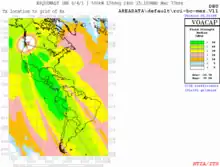
For example, a "HRS 4/5/0.5" curtain antenna has a rectangular array of 20 dipoles, 4 dipoles wide and 5 dipoles high, with the lowest row being half a wavelength off the ground, and a flat reflector behind it, and the direction of the beam can be slewed. An HRS 4/4/0.5 slewable antenna with 16 dipoles is one of the standard types of array seen at shortwave broadcast stations worldwide.
- Notes on HRS nomenclature
- HRS antennas of type HRS 1/1/z are undefined as such (such a thing would consist of just a single dipole).
- HRS antennas of type HRS 1/2/z and 2/1/z exist, but see little practical use in shortwave broadcasting. An antenna with the designation of "H 1/2/z" is commonly referred to as a "Lazy-H" antenna. VHF and UHF repeaters for FM radio or television in the UK quite often employ a pair of horizontal dipoles (or short yagis) one above the other (i.e. HRS 1/2/z) to concentrate transmission power in the vertical plane.
- The Russian Duga Over The Horizon Radar may have used an antenna of type HRS 32/16/0.75 (estimated – not verified), with potential directional ERP in the gigawatt range.
HRS antenna
The HRS type antenna is one of the most common types of curtain array. The name comes from the above CCIR nomenclature: it consists of an array of Horizontal dipoles with a Reflector behind them, and the beam is Steerable. These antennas are also known as "HRRS" (for a Reversible Reflector), but the extra R is seldom used.
However, as far back as the mid-1930s, Radio Netherlands was using a rotatable HRS antenna for global coverage. Since the 1950s the HRS design has become more or less the standard for long distance (> 1000 km) high power shortwave broadcasting.
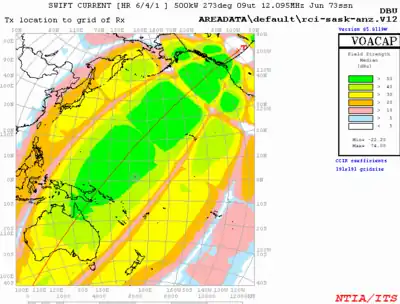
HRS description
An HRS type antenna is basically a rectangular array of conventional dipole antennas strung between supporting towers.[8] In the simplest case, each dipole is separated from the next by 1⁄2 λ vertically, and the centres of each dipole are spaced 1 λ apart horizontally. Again, in the simplest case (for a broadside beam), all dipoles are driven in phase with each other and with equal power. Radiation is concentrated broadside to the curtain.
Behind the array of dipoles, typically about 1⁄3 λ away there will be a "reflector" consisting of many parallel wires in the same orientation as the dipoles. If this was not present, the curtain would radiate equally forward and backward.
Steering
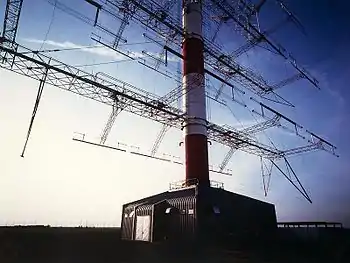
If there is an "S" in the antenna's designation, it is a steerable design. Following the ITU-recommendation, it might be called 'slewable design'.[7] This might be achieved electronically by adjustment of the electrical wave phases of the signals fed to the columns of dipole antenna elements, or physically by mounting the antenna array on a large rotating mechanism. An example of this can be seen at NRK Kvitsøy, where a circular railway carries a pair of wheeled platforms, each of which supports a tower at opposite ends of a diameter-arm. The curtain antenna array is suspended between the towers and rotates with them as the towers go around the circular railway. Another physical rotation technique is employed by the ALLISS system where the entire array is built around a central rotatable tower of great strength.
Electrically slewed antenna arrays can usually be aimed in the range of ±30° from the antenna's physical direction while mechanically rotated arrays can accommodate a full 360°. Electrical slewing is typically done in the horizontal plane, with some adjustment being possible in the vertical plane.
Azimuth beamwidth
- For a 2-wide dipole array, the beamwidth is around 50°
- For a 3-wide dipole array, the beamwidth is around 40°
- For a 4-wide dipole array, the beamwidth is around 30°
Vertical launch angle
The number of dipole rows and the height of the lowest element above ground determine the elevation angle and consequently the distance to the service area.
- A 2-row high array has a typical takeoff angle of 20°
- is most commonly used for medium range communications.
- A 4-row high array has a typical takeoff angle of 10°
- is most commonly used for long range communications.
- A 6-row array is similar to a 4-row, but can achieve 5° to 10° takeoff angles.
- can be used in shortwave communications circuits of 12000 km, and is highly directional.[7]
Note that it is possible for details of the antenna site to wreak havoc with the designers plans such that takeoff angle and matching may be adversely affected.
Examples of HRS antennas
This is an example of theoretical HRS design shortwave relay stations. This may help one better understand HRS antenna directivity.
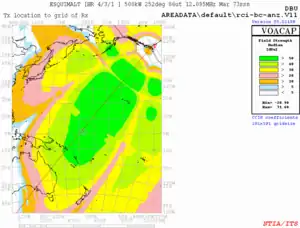 Targeting Australasia
Targeting Australasia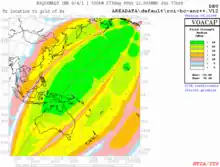 Targeting Indonesia
Targeting Indonesia Targeting Latin America
Targeting Latin America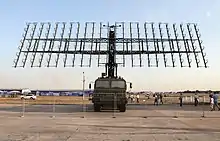 Nebo-M Tactical Radar
Nebo-M Tactical Radar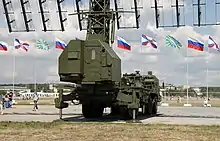 Nebo-M (closeup)
Nebo-M (closeup)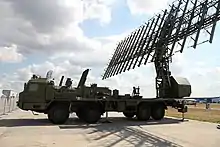 Nebo-M layout
Nebo-M layout
Shortwave relay stations using only HRS antennas
This is an incomplete list of stations using only HRS antennas, sorted by country name.
Active sites
Brazil
- Empresa Brasil de Comunicação Parque do Rodeador
- RNZI Rangitaiki Plains
UK
- BBCWS Ascension Island
- BBCWS Rampisham
- BBCWS Skelton
- BBCWS Woofferton
Decommissioned sites
- CVC International, Darwin, NT at Cox Peninsula. It was formerly a Radio Australia relay station. As the land has been turned over to aboriginal land owners in 2008 by a court decision, the site was dismantled in 2009. It is not currently known if there are any remaining HRS antenna towers.
Germany
- T-Systems Wertachtal site, which is dismantled in 2014.
- Radio Canada International Sackville, NB. Radio Canada International's shortwave service was shut down in June 2012 due to Canadian Broadcasting Corporation budget cuts as a result of reduced federal subsidies. The HRS antenna towers were demolished in 2014.
Spain
- Playa de Pals Radio Station Museum (the HRS antenna field is now a 12-hole golf course)
USA
- VOA Delano, California Relay Station (mothball status, could be reactivated in some emergency situations)
- VOA Greenville-A Relay Station (Site was sold to Beaufort County, North Carolina in 2006, antennas were demolished in 2016.[9])
RADAR Systems using HR Type Antennas
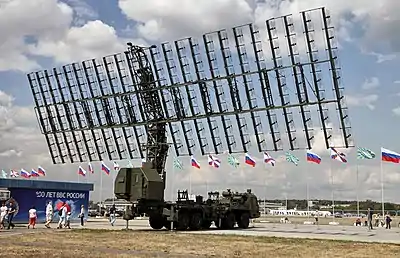
Some portable tactical antenna systems still use HR type antennas, mostly not HRS as the antennas are rotatable.
References
- Griffith, B. Whitfield (2000). Radio-electronic Transmission Fundamentals, 2nd Ed. SciTech Publishing. p. 477. ISBN 1884932134.
- John Bray (2002). Innovation and the Communications Revolution: From the Victorian Pioneers to Broadband Internet. IET. pp. 73–75. ISBN 9780852962183.
- Beauchamp, K. G. (2001). History of Telegraphy. IET. p. 234. ISBN 0-85296-792-6. Retrieved 2007-11-23.
- US Patent no. 1813143, Aerial System Archived 2013-11-09 at the Wayback Machine, E. Bruce, filed Nov 25, 1927, granted July 7, 1931
- US Patent no. 1885151, Directive antenna system Archived 2012-01-27 at the Wayback Machine, E.J. Sterba, filed July 30, 1929, granted November 1, 1932
- Telefunken, Fachbereich Hochfrequenztechnik, Ulm (1976). "Broadband curtain antennas for shortwave broadcasting" (PDF) (in German). Retrieved 2019-05-02.
{{cite web}}: CS1 maint: multiple names: authors list (link) - "Transmitting antennas in HF broadcasting" (PDF). RECOMMENDATION ITU-R BS.80-3. Retrieved 2019-07-22.
- http://www.antenna.be/tci-611.pdf
- WITN. "NEW VIDEO - Implosions bring down 48 VOA towers in Beaufort County". www.witn.com. Archived from the original on 2019-06-29. Retrieved 2019-06-13.
External links
ALLISS Technology portals